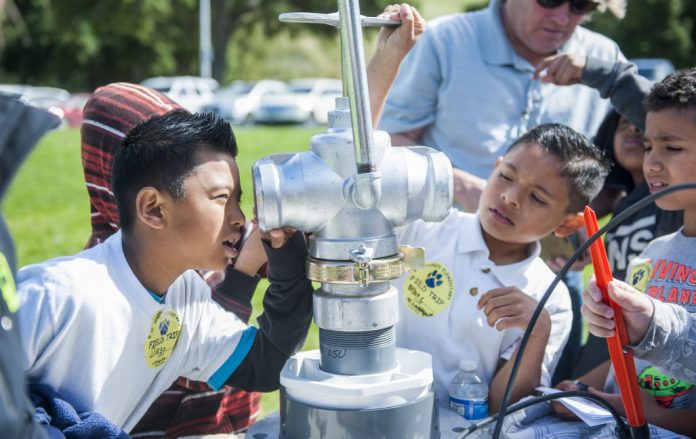
Aromas resident David Casillas and his daughter watched as the black and white dairy cow munched on hay and looked out at a crowd of third graders.
“It’s a tradition,” said Melanie Mahler, a third-grade teacher at Aromas School. “We come every year. They make it very easy because they provide a bus.”
Students participating in Farm Day, recently hosted by the San Benito County Farm Bureau, gathered at Bolado Park where many kids in the county caught their first glimpse of horses, chickens, ducklings and farm equipment.
Casillas was particularly impressed by the 4-H and FFA students who presented at many of the animal stations.
“It gives these kids a chance to see what other kids are doing with their free time,” he said.
Prior to meeting a cow, his daughter’s class had witnessed wool spun into yarn, learned that about 80 percent of a pig carcass is used by people, and studied proper techniques to measure a horse, Casillas said. The process made him grateful for his more rural, agriculture-oriented community.
“It’s actually kind of sad, the cities where you don’t think about any of this,” he said. “Makes you appreciate the simple things.”
Not far away, in the area of Bolado Park typically occupied by livestock during the annual county fair, FFA students shared ducklings with elementary school students and taught the youth proper names for “mama ducks” and “daddy ducks.”
“So how many of you have seen a baby duck?” asked Noah Janzing, 17, a member of FFA and a junior at San Benito High School, as the students’ hands shot up. “So about half of you.”
Ducks weren’t the only poultry on display as 4-Her Emilie Sarringhaus, 13, also shared her pet chicken with crowds. The teenager held Joyful, a five-year-old hen she has owned since she was a chick, in her arms.
“A lot of people when they walk by, you can tell they’ve never seen a chicken up close, let alone pet one,” she said.
Other students, like those at the rural Jefferson School, near Pinnacles National Park, were quite familiar with animal husbandry.
“We’re kind of unique,” said Alex Ferenz, the school’s principal and teacher. “We’re a small, one-room schoolhouse.”
The school’s students work with animals and are the sons and daughters of ranchers, not farmers, the teacher said. Both produce food, but farmers produce crops, while ranchers focus on cattle, he explained.
Meanwhile, Casillas was hoping his daughter, who expressed an interest in participating in 4-H or FFA, might join the program. It emphasizes responsibility, since the youth take care of their own animals.
“There’s not many counties where there’s only five cities and the cows outnumber the people,” he said. “It allows the kids to see what San Benito County is.”









